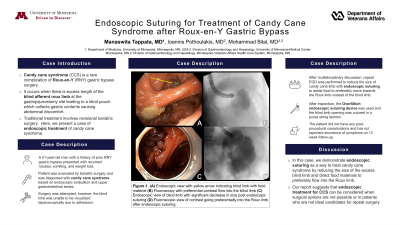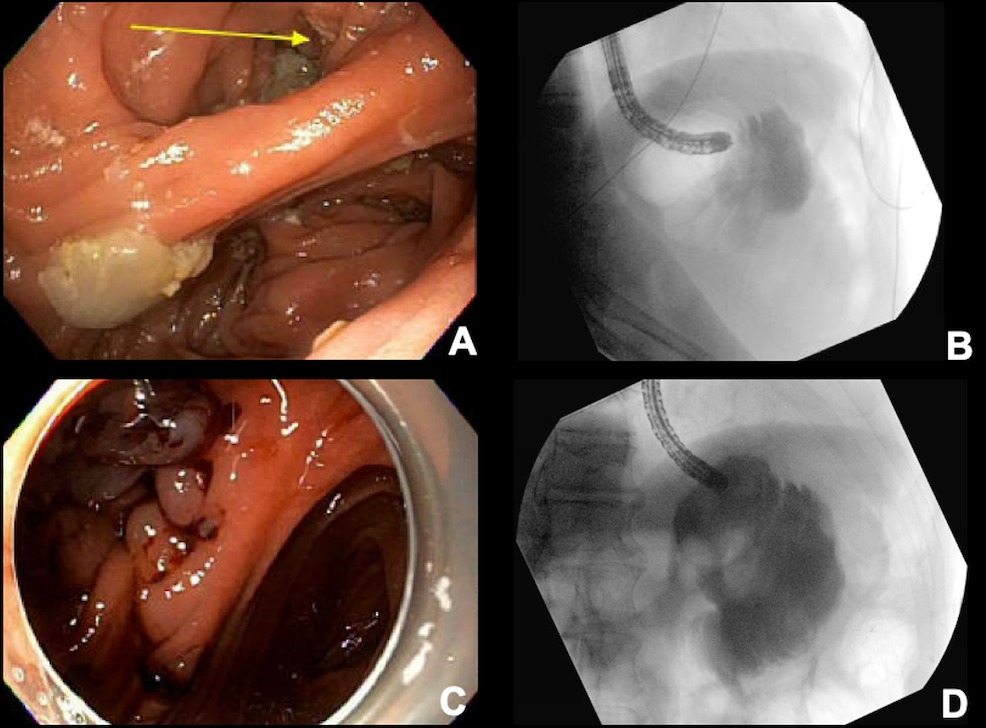Monday Poster Session
Category: Interventional Endoscopy
P2320 - Endoscopic Suturing for Treatment of Candy Cane Syndrome After Roux-en-Y Gastric Bypass
Monday, October 23, 2023
10:30 AM - 4:15 PM PT
Location: Exhibit Hall

Has Audio
- MT
Manaswita Tappata, MD
University of Minnesota
Minneapolis, MN
Presenting Author(s)
Award: Presidential Poster Award
Manaswita Tappata, MD1, Ioannis Pothoulakis, MD1, Mohammad Bilal, MD2
1University of Minnesota, Minneapolis, MN; 2Minneapolis VA Medical Center, Minneapolis, MN
Introduction: Candy cane syndrome (CCS) is a rare complication of Roux-en-Y (RNY) gastric bypass surgery which occurs when there is excess length of the blind afferent roux limb at the gastrojejunostomy site leading to a blind pouch which collects gastric contents causing abdominal discomfort. Traditional treatment involves revisional bariatric surgery, but there is limited data regarding endoscopic options. Here, we present a case of endoscopic treatment of candy cane syndrome.
Case Description/Methods: A 51-year-old man with a history of prior RNY gastric bypass presented with recurrent nausea, vomiting, and weight loss. The patient was evaluated by bariatric surgery and after extensive work up was diagnosed with candy cane syndrome based on endoscopic evaluation and upper gastrointestinal series. Surgery was attempted; however, the blind limb was unable to be visualized laparoscopically due to adhesions. The patient was then referred to Gastroenterology for possible endoscopic management of candy cane syndrome. Esophagogastroduodenoscopy (EGD) with fluoroscopy and contrast injection into the lumen showed preferential contrast flow into the excess blind limb and food was seen in the excess blind limb suggestive of CCS (Figure 1A and 1B). After multidisciplinary discussion, a repeat EGD was performed to reduce the size of the candy cane limb with endoscopic suturing to assist food to move away from the blind roux limb and towards the Roux limb. EGD showed healthy appearing mucosa of the gastrojejunal anastomosis. After inspection, the OverStitch endoscopic suturing device was used and the blind limb opening was sutured in a purse string fashion. The candy cane limb was significantly smaller on repeat inspection (Figure 1C). Contrast was injected at the end of the procedure and fluoroscopy showed contrast flowing preferentially into the Roux limb (Figure 1D). The patient did not have any post-procedural complications and has not reported recurrence of symptoms on 12 week follow-up.
Discussion: CCS is typically managed with laparoscopic or open surgical resection of the limb. In this case, we demonstrate endoscopic suturing as a way to treat candy cane syndrome by reducing the size of the excess blind limb and direct food materials to flow into the Roux limb. Our report suggests that endoscopic treatment for CCS can be considered when surgical options are not possible or in patients who are not ideal candidates for repeat surgery.

Disclosures:
Manaswita Tappata, MD1, Ioannis Pothoulakis, MD1, Mohammad Bilal, MD2. P2320 - Endoscopic Suturing for Treatment of Candy Cane Syndrome After Roux-en-Y Gastric Bypass, ACG 2023 Annual Scientific Meeting Abstracts. Vancouver, BC, Canada: American College of Gastroenterology.
Manaswita Tappata, MD1, Ioannis Pothoulakis, MD1, Mohammad Bilal, MD2
1University of Minnesota, Minneapolis, MN; 2Minneapolis VA Medical Center, Minneapolis, MN
Introduction: Candy cane syndrome (CCS) is a rare complication of Roux-en-Y (RNY) gastric bypass surgery which occurs when there is excess length of the blind afferent roux limb at the gastrojejunostomy site leading to a blind pouch which collects gastric contents causing abdominal discomfort. Traditional treatment involves revisional bariatric surgery, but there is limited data regarding endoscopic options. Here, we present a case of endoscopic treatment of candy cane syndrome.
Case Description/Methods: A 51-year-old man with a history of prior RNY gastric bypass presented with recurrent nausea, vomiting, and weight loss. The patient was evaluated by bariatric surgery and after extensive work up was diagnosed with candy cane syndrome based on endoscopic evaluation and upper gastrointestinal series. Surgery was attempted; however, the blind limb was unable to be visualized laparoscopically due to adhesions. The patient was then referred to Gastroenterology for possible endoscopic management of candy cane syndrome. Esophagogastroduodenoscopy (EGD) with fluoroscopy and contrast injection into the lumen showed preferential contrast flow into the excess blind limb and food was seen in the excess blind limb suggestive of CCS (Figure 1A and 1B). After multidisciplinary discussion, a repeat EGD was performed to reduce the size of the candy cane limb with endoscopic suturing to assist food to move away from the blind roux limb and towards the Roux limb. EGD showed healthy appearing mucosa of the gastrojejunal anastomosis. After inspection, the OverStitch endoscopic suturing device was used and the blind limb opening was sutured in a purse string fashion. The candy cane limb was significantly smaller on repeat inspection (Figure 1C). Contrast was injected at the end of the procedure and fluoroscopy showed contrast flowing preferentially into the Roux limb (Figure 1D). The patient did not have any post-procedural complications and has not reported recurrence of symptoms on 12 week follow-up.
Discussion: CCS is typically managed with laparoscopic or open surgical resection of the limb. In this case, we demonstrate endoscopic suturing as a way to treat candy cane syndrome by reducing the size of the excess blind limb and direct food materials to flow into the Roux limb. Our report suggests that endoscopic treatment for CCS can be considered when surgical options are not possible or in patients who are not ideal candidates for repeat surgery.

Figure: Figure 1. (A) Endoscopic view with yellow arrow indicating blind limb with food material (B) Fluoroscopy with contrast in the blind limb (C) Endoscopic view of blind limb post-suturing (D) Fluoroscopic view of contrast going preferentially into the Roux limb.
Disclosures:
Manaswita Tappata indicated no relevant financial relationships.
Ioannis Pothoulakis indicated no relevant financial relationships.
Mohammad Bilal: Boston Scientific – Consultant.
Manaswita Tappata, MD1, Ioannis Pothoulakis, MD1, Mohammad Bilal, MD2. P2320 - Endoscopic Suturing for Treatment of Candy Cane Syndrome After Roux-en-Y Gastric Bypass, ACG 2023 Annual Scientific Meeting Abstracts. Vancouver, BC, Canada: American College of Gastroenterology.

